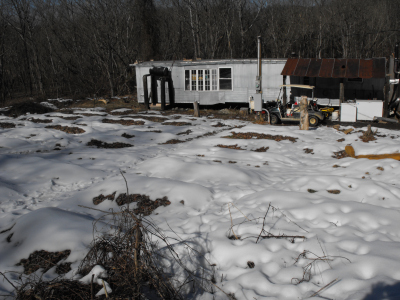
Warming trend
 The temperatures rose above
freezing at last, and the month-old snow began to creep back toward the
hill. The first daffodil leaves peeked through the soil in the
sunniest spot, and an amorous cardinal started to sing.
The temperatures rose above
freezing at last, and the month-old snow began to creep back toward the
hill. The first daffodil leaves peeked through the soil in the
sunniest spot, and an amorous cardinal started to sing.
I celebrated by washing
our laundry, pumping water down the hill from the thousand
gallon tank since our water line is still frozen. Then I
turned off the pump...and water kept right on flowing. Gotta love
capillary action! Now I know that I only need to use electricity
to get the suction started --- after that, water will flow four feet up
out of the tank all by itself!
Want more in-depth information? Browse through our books.
Or explore more posts by date or by subject.
About us: Anna Hess and Mark Hamilton spent over a decade living self-sufficiently in the mountains of Virginia before moving north to start over from scratch in the foothills of Ohio. They've experimented with permaculture, no-till gardening, trailersteading, home-based microbusinesses and much more, writing about their adventures in both blogs and books.
Want to be notified when new comments are posted on this page? Click on the RSS button after you add a comment to subscribe to the comment feed, or simply check the box beside "email replies to me" while writing your comment.
RSS
Warming
As you have found out syphons are a good thing to know about. As long as the discharge is lower than the suction and no air is let into the suction, you can lift liquids quite high. Many pumps have a suction lift of up to 28 feet so it is possible to move a lot once you get it going and turn off the pump. Just remember the only enemy of a syphon is an air leak.
Comment by
vester
— Sat Jan 16 10:21:14 2010
- Remove comment
comment 2
28 feet with the pump off --- that's amazing!!! I can't believe I've been running the pump the whole time in situations like this --- a waste of energy!
Comment by
anna
— Sat Jan 16 12:50:11 2010
- Remove comment
Drilling Ice
We've had to clear frozen water lines many times over the years. They are 1" black plastic pipes. What we do is feed a 1/2" plastic pipe up (or down) the frozen pipe feeding hot water into the end of the smaller diameter pipe. This drills through the ice and clears it out of the larger frozen pipe. A funnel on the end of the half inch pipe works out in the field or if you're close enough to the house connect it to the hot water of the house with a hose - just avoid back flow to your potable supply. Not an issue in this case though.
Comment by
Walter Jeffries
— Sat Jan 16 15:57:32 2010
- Remove comment
comment 4
Those are really good ideas --- I'll keep them in mind for days when we really need water. At the moment, we tend to take the wait-and-see approach --- if the lines are frozen, we wait and see if they'll thaw tomorrow. 

Comment by
anna
— Sat Jan 16 18:24:37 2010
- Remove comment
Add a comment
